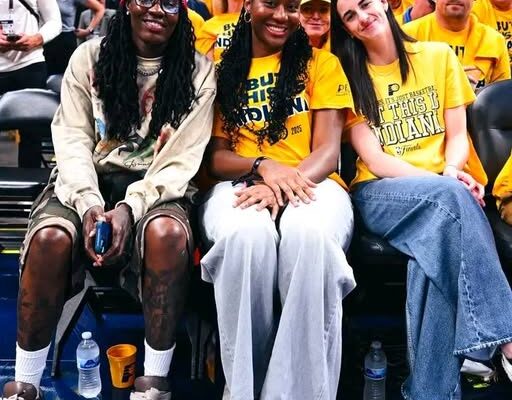The spotlight was bright and the energy electric as fans filled the arena for Game 3 of the Indiana Pacers’ playoff series, but amid the excitement on the court, a significant moment was also unfolding just feet away on the sidelines. Sitting courtside, soaking in the atmosphere and supporting their fellow Indiana team, were three standout stars of the WNBA’s Indiana Fever: Caitlin Clark, Aliyah Boston, and Natasha Howard. It wasn’t just a simple night out—it was a powerful image of solidarity, connection, and the merging of two elite basketball worlds within the same city. The presence of these three athletes at the game spoke volumes, resonating with fans, media, and fellow athletes alike.
Caitlin Clark, a rookie sensation whose entry into the WNBA has captured national attention, has quickly become one of the most recognizable names in sports. Her record-breaking college career at Iowa made headlines on a weekly basis, and her transition to the professional level has brought both excitement and high expectations. Her sitting courtside at the Pacers game wasn’t just a celebrity sighting; it was another chapter in the story of a rising star embracing her role as a central figure in Indiana’s growing basketball culture. She wasn’t there to make headlines—though she inevitably did—but rather to show support and immerse herself in the basketball community that has welcomed her with open arms.
Next to her was Aliyah Boston, the 2022 NCAA Champion and the Fever’s number one draft pick from the year prior. Boston, already an established star in the league, has continued to grow as both a dominant post presence and a vocal leader for the Fever. Her poise, skill, and consistency have earned her widespread respect, and her presence at the Pacers game underscored her investment in Indiana basketball as a whole. Watching the game intently, cheering during big plays, and engaging with fans, Boston’s courtside attendance symbolized more than just fandom—it was about being part of a larger sporting family and a shared journey toward success.
Completing the trio was Natasha Howard, a seasoned WNBA veteran, champion, and All-Star whose leadership and experience have been instrumental for the Fever’s younger players. Howard has long been known for her ability to impact games on both ends of the floor, but her role goes far beyond stats and accolades. She’s a mentor, a competitor, and a stabilizing force. Sitting alongside two rising stars, Howard represented the bridge between past triumphs and future aspirations. Her presence lent a sense of continuity and reminded everyone that progress in sports is often built on a foundation of shared wisdom, camaraderie, and mutual respect.
The sight of the three Fever players courtside wasn’t lost on the crowd, nor on the broadcasters and social media channels that buzzed with excitement. Fans captured selfies and posted clips of the trio reacting to big moments in the game, while commentators praised the visibility and presence of WNBA players supporting their NBA counterparts. In a time when the growth of women’s sports is finally getting more of the attention it deserves, moments like this carry additional weight. They highlight the mutual respect between professional athletes, the support that extends across leagues, and the importance of visibility for women in sports.
Indiana is a basketball state through and through. From high school gyms to collegiate arenas, and now with both the Pacers and Fever playing on prominent stages, the sport is deeply woven into the state’s cultural fabric. When WNBA players show up for NBA games—not as spectators, but as peers—it’s a reflection of that shared legacy. The gesture also encourages fans to recognize the talent, passion, and competitive fire that exists on both sides of the professional basketball spectrum. It says something powerful about the unity and potential of Indiana basketball, both male and female, working in tandem to create something special for the state and its fans.
The timing of the trio’s courtside appearance couldn’t have been better. With the WNBA season underway and the Fever continuing to build their identity, showing support for another Indiana team in the midst of a high-stakes playoff run was symbolic. It reminded fans that sports are about more than wins and losses—they’re about community, pride, and shared goals. The Fever and the Pacers may play in different leagues, but they represent the same city, the same state, and the same loyal fan base. Seeing athletes from the women’s team support the men’s team reinforces a sense of unity that can inspire fans to reciprocate that support when the Fever take the floor.
For Clark, Boston, and Howard, the experience was also a chance to soak in the atmosphere of a playoff game at its highest level. The intensity, the crowd noise, the pressure-filled moments—all of it resonates across sports, and for players competing at the elite level themselves, there’s a shared appreciation for what it takes to perform on such a stage. It also serves as a motivating factor. Watching another team fight for a championship fuels that same hunger, and for athletes as driven as those three, the courtside experience may have offered both inspiration and an emotional recharge.
Moments like this are part of a larger shift taking place in sports culture. Visibility matters, and when fans see WNBA stars front and center at major events, it changes perceptions. It signals that women’s athletes are not just supporting characters—they are part of the same ecosystem, deserving of equal spotlight, respect, and attention. These courtside appearances create cross-pollination of fandom. Fans who may have tuned in to watch the Pacers are now reminded of the incredible talent within the Fever organization and may feel inspired to buy a ticket, watch a game, or follow a player’s journey more closely.
There’s also a powerful message sent to young athletes watching from home. Seeing three elite women basketball players sitting courtside, confident, present, and celebrated, sends the message that success is multifaceted. You can be talented and visible, competitive and collaborative, humble and proud. You can be a rookie, a rising star, or a veteran and still have something important to contribute to the game and to the culture around it. Representation on this level isn’t just about marketing or optics—it’s about reshaping narratives, empowering future generations, and recognizing excellence in all its forms.
The media coverage following the game reflected this understanding. Articles, tweets, and highlight reels included not just the action on the court but the reactions and presence of Clark, Boston, and Howard. Fans debated outfits, captured smiling exchanges, and celebrated the unity on display. The moment became part of the story of Game 3—not as a sideshow, but as an integral part of the event. It illustrated how modern sports are increasingly about the community around them: who’s watching, who’s supporting, and who’s part of the larger cultural conversation.
For the Indiana Fever organization, this kind of visibility is invaluable. It reinforces the identity of the team within the broader Indiana sports ecosystem and reminds fans that something special is being built with this group of players. Caitlin Clark brings national attention and new fans. Aliyah Boston offers consistency, leadership, and potential All-Star dominance. Natasha Howard brings championship experience and a mentor’s presence. Together, they’re forming the core of a team that is working not just to compete, but to redefine what success looks like in the WNBA.
As the night wound down and the final buzzer echoed through the arena, the cameras may have shifted back to the court, but the image of Clark, Boston, and Howard courtside lingered in the minds of many. It was more than just three athletes watching a game—it was a snapshot of a changing sports culture. One where mutual respect, cross-league support, and shared fandom thrive. One where women’s basketball is no longer in the background but firmly part of the main stage.
Their presence was a statement: we are here, we are invested, and we are just getting started.



